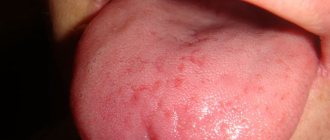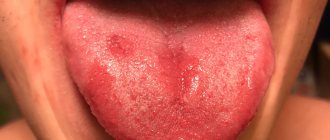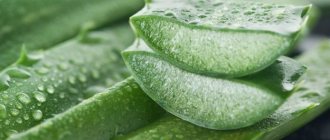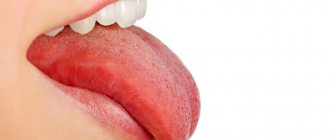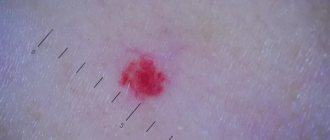General information
As such, the medical term “pimple on the tongue” does not exist.
Rather, it is a collective term in everyday spoken language, reflecting the appearance on the tongue of adults and children of formations (swellings, tubercles, nodules, vesicles) of various origins. Depending on the reason for their appearance, they can be of different colors (red, white, yellow, pink). Often, such pimples appear in other parts of the oral cavity: on the palate, on the mucous membrane of the mouth, on the lip, and often there is a pimple on the gum above the tooth. Less common is a blister filled with pus on the gum (purulent pimple on the gum). In a healthy person, the mucous membrane of the tongue is normally pale pink in color, and the papillae are slightly pronounced. The bulk of the tongue is made up of muscular striated tissue, intertwined in three perpendicular directions, between which there is connective tissue in which blood vessels and nerve fibers pass.
It should be noted that changes in the oral mucosa and the immediate condition of the papillae of the tongue (size, plaque on it, color) are often a kind of indicator of impaired functioning of the body, and most often the presence of pimples on the tongue is one of the signals of the appearance of certain problems (mainly from the gastrointestinal tract), vitamin deficiency . Such phenomena may also indicate the appearance of diseases such as glossitis , stomatitis , an allergic reaction , vitamin deficiency , infectious diseases, for example, with scarlet fever , when the tongue becomes crimson in color and the papillae on the tongue increase sharply.
However, the appearance of pimples on the tongue is not always caused by a disease. They are often the result of mechanical trauma from eating solid foods (crackers, chips, seeds) or the manifestation of a local allergic reaction to any foods or medications/oral care products. Pimples in the mouth in adults often cause discomfort to the patient, can be painful, and interfere with eating and talking. Let us consider below why they appear, what they are like and what to do when they appear.
Location: on the base
Pimples at the base of the tongue interfere with swallowing and even speaking, they hurt and cause a lot of trouble. The reasons for their appearance can be very diverse. It could be stomatitis, a fungal infection, a sore throat or pharyngitis. Only an experienced doctor can make a correct diagnosis. We can only suggest what you should pay attention to.
If a pimple appears on the base of the tongue, you should carefully analyze other symptoms - fever, enlarged lymph nodes, the presence of allergic reactions. For example, with a sore throat, pimples form in the throat quite often. They are painful, make swallowing difficult and cause pain when talking. In this case, the patient also has enlarged tonsils and submandibular lymph nodes, and an elevated temperature. As a matter of fact, acne and fever almost always occur either with a sore throat, or with tonsillitis or pharyngitis.
It is undesirable to ignore pimples on the tongue near the throat, since in particularly advanced cases they can interfere with breathing, which can lead to suffocation. Therefore, having discovered them in yourself, you need to contact an ENT specialist for a diagnosis.
Pathogenesis
The pathogenetic mechanisms of the development of various types of formations on the tongue are based on different processes - proliferative inflammation, dystrophies, tumor processes, sensitization of the body (specific/nonspecific) and allergic manifestations, injuries to the mucous membrane of the tongue, causing morphological, biochemical and functional disorders in the tissues of the tongue. Accordingly, the basis of morphological changes/reactions of tongue tissues is the reproduction/transformation of cellular structures, promoting the formation and proliferation of granulation tissue structures, atypical hyperplasia of the epithelial mucosa, which is manifested by the formation of granulomas , tubercles , nodules , vesicles and their necrotic changes of varying severity, characteristic of those or other diseases of the body and oral cavity, in particular.
Preventive measures
Simple preventative measures will prevent the onset of the disease. Basic rules of behavior and hygiene:
- Fruits and vegetables should always be washed before consumption.
- Food should not be excessively hot, cold, spicy or rough.
- The chewing process should be slow, which will prevent tongue biting.
- Personal hygiene should be observed: dental and oral care.
- It is necessary to have individual cutlery and a toothbrush.
- The brush should be renewed monthly. Change immediately after an illness.
- Regular visits to the dentist are recommended. It is necessary to treat diseases of the teeth and oral cavity in a timely manner, remove tartar and plaque, because these are the main sources of infection in the mouth.
- It is necessary to maintain adequate physical activity, which will increase immunity and the condition of the entire body.
Any pimple, growth or tubercle on the mucous membrane, both in an adult and in a child, requires close attention. You should not treat the bumps yourself; only a doctor can do this.
You should not pierce or try to squeeze out pimples on the mucous membrane; such actions can lead to negative consequences: the growth of foci of inflammation, the appearance of open wounds as a result of injuries.
The best thing a person can do if they have bumps on their tongue is to see a dentist or therapist. Such a decision will speed up recovery and prevent possible complications.
Classification
As such, there is no classification of formations in the tongue, since their appearance is influenced by numerous exogenous/endogenous influence factors. Some authors classify these phenomena from an etiological point of view, and therefore distinguish several groups:
- Formations in the tongue of traumatic origin - acute and chronic mechanical trauma of the tongue, chemical trauma, physical factors (high/low temperatures).
- Formations on the tongue caused by local/general infection. Infectious agents in the oral cavity are often various strains of viruses ( adenovirus , retrovirus , herpes simplex virus , measles virus , HIV ), staphylococcus , streptococcus , fungi , fusospirillum .
- Formations in the tongue associated with sensitization of the body/disorders of immune processes. Such formations are based on the presence of reactive zones on the oral mucosa that react in a certain way upon contact with allergens of various origins (toxins, foods, drugs, etc.), contributing to the development of autoimmune reactions.
What to do
The human oral cavity is home to many bacteria, both beneficial and pathogenic. They have both negative and positive effects on the human body. Pathogenic bacteria cause inflammatory processes, including glossitis, or inflammation of the tongue. Often patients notice a white pimple that reacts with pain to every touch. In fact, this is not a pimple, but an inflamed nodule. In medicine, such inflamed nodules are called glossitis.
A transparent pimple under the tongue can occur as a result of mechanical damage or as an allergic reaction to chemical and food irritants.
You can get rid of glossitis only through comprehensive measures. The first step is to consult a doctor to determine the true cause of its occurrence. The oral cavity should be kept clean, preferably rinsed with a soda solution or a decoction of St. John's wort. It is also necessary to strengthen the immune system and limit the consumption of spicy and too hot foods so as not to irritate the inflamed nodule.
Causes
The causes of pimples on the tongue are quite diverse and can be both local and general. The main reasons include:
- Mechanical/chemical damage of various origins (shards of fillings, sharp edges of teeth, low-quality metal crowns, hot/cold food, dentures). These are predominantly formations on the tip of the tongue or on the side.
- Insufficient/improper oral hygiene care.
- Exposure to infectious agents (bacteria, viruses and fungi), which can, under some conditions, cause inflammation and red pimples on the tongue closer to the throat.
- Uncontrolled long-term use of antibacterial drugs.
- Bad habits: smoking and abuse of alcohol-containing drinks, which irritate the oral mucosa.
- Hypo / vitaminosis (lack of vitamins (B6, PP, B12, A, E) and iron, accompanied by an increase in the papillae of the tongue (red papillae over the entire surface of the tongue).
- Diseases of the gastrointestinal tract ( gastritis , gastric ulcer , hepatitis , cholecystitis , chronic colitis . Formations are located at the root of the tongue, that is, closer to the throat.
- Endocrine disorders: hypothyroidism , diabetes , menopause .
- Candidal single lesion of the oral mucosa (white pimple on the side of the tongue).
- Allergy to prosthetic material (usually acrylic structures containing methacrylic acid ester).
Location: at the tip
A white pimple on the tip of the tongue can appear at the site of a microtrauma as a result of an infection entering the wound. Fans of chips, seeds, pistachios and other nuts are especially susceptible to developing pimples on the tip of the tongue. Solid foods scratch the delicate tip of the tongue, causing pathogenic bacteria to enter the wound, causing it to become inflamed and painful.
Often a pimple occurs due to an exacerbation of the herpes simplex virus against the background of decreased immunity. In this case, strengthen your immune system and take vitamin complexes. But in any case, consult a doctor and get tested to make an accurate diagnosis.
Also, a pimple can pop out due to chronic stomatitis. If the patient has a weakened immune system and has carious teeth, persistent infection in the oral cavity sooner or later leads to stomatitis. Without timely treatment, it can become chronic, periodically exacerbating.
Symptoms
They manifest themselves by the appearance on the tongue, and often on the oral mucosa, of formations of various colors, shapes and sizes, resembling pimples in appearance (photo below).
They can be either painless or accompanied by pain, especially when swallowing and talking. Less common are redness of the tongue, burning, swelling, increased salivation, and impaired motor function of the tongue/speech. However, in any case, their appearance causes discomfort.
What to do, how to treat
Treatment of a rash on the tongue, regardless of the cause, will be easier if the patient has a strong immune system. In this case, it will prevent the occurrence of inflammation and become a barrier to the penetration of the virus. Therefore, it is necessary to take medications that help improve the functioning of the immune system.
General drug therapy
The most effective drugs:
- Sodium tetraborate . A solution used to treat the oral cavity for candidiasis and stomatitis.
- Nystatin . An antimicrobial agent to get rid of rashes on the tongue. The tablet solution is applied to gauze and the surface of the tongue is treated 3 times a day.
- Kamistad . A local remedy for treating affected areas of the oral mucosa with an anesthetic and anti-inflammatory effect.
- Holisal . Antimicrobial gel. Acts as a local anesthetic that eliminates inflammation on the tongue.
- Ambassador . An aerosol that relieves various difficulties in the oral cavity. Eliminates inflammation, accelerates tissue healing.
- Furacilin . Tablets that are diluted in water to rinse the mouth.
Sodium tetraborate
Nystatin
Kamistad
Holisal
Ambassador
Furacilin
Any remedy should be used only after medical advice.
Local therapy
It is possible to eliminate the pathology using local treatment:
- constant oral hygiene;
- applying calcium toothpaste to the growth;
- rinsing with soda solution every 3 hours;
- applications from sea buckthorn oil, rose hips, peach;
- applying lotions with vodka to reduce symptoms.
A rash on the tongue, regardless of the provoking factors, must be treated by improving the functioning of the immune system, which will become an obstacle to the occurrence of various inflammatory processes.
Traditional methods at home
Before starting home therapy, you should make sure that the rash on the tongue is not the result of dangerous viral diseases or other pathogenesis. Therefore, it is imperative to consult a specialist.
Most popular recipes:
| Means | Description |
| Peach oil | This product quite effectively disinfects the affected area, removes unpleasant symptoms in the shortest possible time and softens the tissue, relieving discomfort. The oil is applied to a cotton pad or a piece of gauze is soaked generously. The pimple and mucous membrane are lubricated with it. |
| Rinse | To eliminate rashes located on the tongue, rinses are used, which are prepared from medicinal herbs, famous for their restorative and anti-inflammatory effects. |
| Diamond green | Using such a remedy effectively eliminates a rash on the tongue. Each growth is carefully processed by her. The manipulation is carried out several times a day. |
| Aloe or Kalanchoe | A cotton pad is soaked in the juice of these plants and applied to the damaged area. Using a paste of leaves will be effective. The product has an unpleasant taste, however, it makes it possible to eliminate the symptoms of the pathology in the shortest possible time. |
Tests and diagnostics
The diagnosis is made based on examination of the oral cavity and patient complaints. If necessary, laboratory and instrumental examinations are carried out:
- Bacterioscopic examination - scraping from the mucous membrane of the tongue and microscopy of Gram-stained smears.
- Bacteriological examination (culture of material from the oral cavity on nutrient media).
- Analysis of saliva for the presence of an infectious agent.
- Blood sugar test.
- Clinical/biochemical blood test
- If necessary, gastroscopy, ultrasound of the abdominal organs to identify gastrointestinal diseases.
Pimples on the tongue - what are they?
The mucous membrane in the mouth and tongue does not have sebaceous glands, so typical pimples cannot form on it. Such formations have two formation mechanisms:
- Under the influence of damaging factors, viruses or bacteria, the mucous membrane stratifies, under the top layer of which liquid accumulates and small bubbles form. If such a formation is not infected, then its contents will be transparent, but if infection has penetrated into its cavity, then suppuration is possible - the vesicle will turn white. If blood gets into the liquid, then this formation takes on a red or dark tint. The blisters may burst and painful ulcers form in their place.
- Sometimes, in response to inflammation, cells on the surface of the tongue begin to actively divide and slough off. Whitish or red formations form that resemble ordinary pimples, but at the same time they are only enlarged papillae.
In children
Dental diseases in a child are determined not only by the presence of pain in the mouth, but also by the appearance of painless rashes on the mucous membrane, which parents call “pimples.” Pimples in a child's mouth are actually inflammatory swellings, bumps, watery blisters or nodules that are not pimples. The oral mucosa is very sensitive to various influences, so even a slight provocation causes inflammation. It could be:
- unbalanced diet;
- weakening of protection after illness;
- changes in intestinal microflora;
- activation of opportunistic oral flora.
Any changes in the oral cavity are a signal from the body that you need to pay attention to. On the one hand, the appearance of rashes may indicate pathology of internal organs or dental diseases. On the other hand, a favorable environment for the proliferation of microorganisms in the mouth can lead to the fact that a minor crack, in the absence of treatment and hygiene, quickly becomes inflamed and suppurates. With the participation of various microorganisms in the mouth, various dental diseases develop in children - most often they are caused by streptococci, fungi, and staphylococci. Also, do not forget about changes in the oral mucosa during infectious diseases ( influenza , measles , scarlet fever , chicken pox , infectious mononucleosis , fungal infection).
It makes sense to consider a common disease in children, which is accompanied by the appearance of various elements on the oral mucosa. Stomatitis is the most common cause of the appearance of elements on the tongue and gums that look like pink or red pimples. The main cause of this disease is the introduction of bacteria to the mucous membrane with dirty hands and toys, unwashed fruits and berries. Small, painful pink or red formations appear on the surface of the tongue. The pain intensifies when eating, talking and swallowing saliva. If the process is not eliminated at this stage, a superficial defect of the mucous membrane of a round or oval shape develops - aphtha ( aphthous stomatitis ). It is covered with a coating of fibrin, which gives it a white or yellowish tint. The edge of the aphtha is surrounded by a red rim.
Red formations on the tongue are a sign of inflammation of the tongue ( glossitis ). Outwardly, they can be mistaken for inflamed pimples. As a result of a burn from hot tea or food, the papillae of the tongue become enlarged and painful, so they can be mistaken for pimples.
In chickenpox, this element is a vial of liquid. The accumulated fluid raises the stratum corneum. The blisters in the mouth quickly burst and small round grayish erosions are formed, which externally resemble aphthae covered with crusts. Chickenpox rashes appear with a difference of 1-2 days, so the elements will be at different stages: papules, vesicles, and then crusts. Also, blisters form with herpetic lesions of the mucous membrane, enterovirus infection and Dühring's dermatitis herpetiformis.
With infectious mononucleosis, enlarged mushroom-shaped papillae appear on the tongue, which are mistaken for pimples. With influenza, catarrhal stomatitis , which involves the soft palate, arches, uvula, cheeks and tongue. Against the background of catarrhal changes, rashes appear like red millet grains. The white dots in the baby are associated with the glandular nodules of Bon - these are the rudiments of the salivary glands located on the soft palate. They usually resolve on their own. White pimples appear with candidiasis - outwardly they look like cheesy layers on the tip of the tongue and under the tongue.
Treatment of pathological formations on the oral mucosa in a child
- An important condition for treatment is the elimination of irritating factors. The child should not be given salty and sour foods, juices, and rough food is not allowed. During illness, food should be pureed (porridge, mashed potatoes, mashed soup, soufflé, pureed cottage cheese), liquid (milk, cream, sweet tea, cocoa).
- Local treatment includes oral care - rinsing with herbal decoctions and antiseptics after each meal and at night. You can use a decoction of sage, chamomile, and calendula. Calendula tincture, 1 teaspoon per glass of water, can be used, which has an antimicrobial and anti-inflammatory effect. For rinsing in children, you can use a solution of Miramistin , Chlorhexidine , an alcohol solution of Citral (25 drops per 0.5 glass of water), a solution of furatsilin , Hydrogen Peroxide (2 tbsp. L per 0.5 glass of water), Stomatofit Fresh , an alcohol solution of Chlorophyllipt ( 1 tsp per 0.5 cup of water), Hexoral , Rotokan , Angiosept . These procedures prevent secondary infections and more serious complications.
- Most diseases of the mucous membrane are of inflammatory origin, therefore, locally, in addition to rinsing, irrigation with antiseptics in the form of a spray is prescribed ( Stopangin , Kollustan , Ectericide with chlorophyllipt , Rotocan-Vialine ). Older children can dissolve tablets or pastes ( Strepsils , Ingalipt Vialine Ingaliptum Ultravirk paste , Faringosept , Gramicidin , Neo-Angin ).
- For severe pain, local anesthetics are used. An alcohol solution of propolis (4-20%) in addition to having an antimicrobial effect, also has an analgesic effect. For topical anesthesia, propolis tincture is used with oils (peach, sea buckthorn, rosehip) or glycerin: take 4 drops of tincture and 10 drops of oil. A decoction of mint leaves as a gargle can also be used as a pain reliever. For pain, enveloping decoctions of flax seed and marshmallow root are used.
Why do they appear?
As already mentioned, there are no sebaceous glands on the tongue, so “pimples” cannot appear on it in principle. After all, a pimple is an inflammation of the sebaceous gland. But the bumps and nodules that sometimes appear on the surface are very similar in appearance to pimples, which is why they got that name. Pimples under the tongue or on the tip cause a lot of trouble and are extremely painful. Let's consider the reasons for their appearance.
Mechanical damage
Often, in the process of chewing or biting food, we bite our tongue, resulting in a slight mechanical injury. The risk of surface damage increases when consuming hard foods with sharp edges (crackers, chips, seeds). A small painful swelling or bump forms at the site of the injury, which after some time turns into a white pimple. The pain intensifies while eating. With severe mechanical damage, slight swelling may occur.
You should exclude spicy and hot foods from your diet, carefully monitor oral hygiene, and after a few days the pimple will disappear on its own.
Allergic reaction
The appearance of pimples on the tongue may indicate an allergic reaction to food, medicine or toothpaste. In this case, small white pimples and sores form, which hurt and irritate when eating or drinking liquid.
If your doctor suspects an allergy, it is very important to identify the allergen and eliminate it from your diet. First of all, you should stop chewing gum, change toothpaste and tooth elixir - you may be allergic to oral hygiene products. If these measures do not bring the desired result, you need to analyze whether you have recently taken medications. Pimples on the tongue after antibiotics and other medications are a common occurrence. In this case, you should consult your doctor and stop taking the drug or try replacing it with another one.
If the cause of acne is a food allergy, you need to track what foods they appear after and eliminate these foods from your diet.
Stomatitis
Stomatitis is a common cause of white or red pimples on the surface of the tongue. The main cause of stomatitis is insufficient oral hygiene, exposure to pathogenic bacteria on the mucous membranes due to dirty hands, unwashed fruits and vegetables. Most often, children suffer from stomatitis, because they tend to put everything in their mouth.
With stomatitis, small white, pink or red pimples appear on the surface of the tongue and other mucous membranes of the mouth, which burn, irritate and hurt not only during eating, but also at rest. It is sometimes difficult not only to eat, but also to talk or simply swallow saliva. Small pimples under the tongue or at the root cause severe discomfort.
At the first suspicion of stomatitis, you should consult a doctor, he will prescribe medications that relieve itching and soreness of the tongue, as well as promote the speedy healing of ulcers and pimples.
Herpes
The herpes virus most often affects the area around the lips. However, this is not the only place where it is localized; herpes can affect all mucous surfaces of the human body, including the oral cavity. In this case, one or more watery pimples may appear on the tongue and inner surface of the cheeks. Many people do not pay enough attention to the herpes virus, believing that it will go away on its own. In fact, this is not such a harmless disease.
Without proper treatment, herpes can eventually affect the entire body, including the brain. Therefore, if you have a herpes virus, you should consult a doctor and undergo a course of antiherpetic therapy.
Poor nutrition
If you eat too much spicy and hot food, inflammation of the tongue, or glossitis, may occur. The papillae on the surface of the tongue are constantly irritated by hot or spicy foods, which leads to their inflammation. If your diet constantly contains spicy foods, inflammation can become chronic.
Drinking alcohol in large quantities, as well as smoking, can cause inflammation of the tongue. Therefore, when the first problems appear, you should immediately try to get rid of bad habits.
Pathologies of the patient's internal organs
Pimples on the surface of the tongue can be a manifestation of various diseases, including candidiasis or tuberculosis. Therefore, you should not take the appearance of small pimples lightly. Be sure to monitor their behavior. If a pimple does not go away for a long time, be sure to consult a doctor.
Weakened immunity
If the immune system is weakened as a result of a previous illness or due to a lack of vitamins and microelements, small painful pimples may appear on the surface of the tongue. If there are no other reasons for their appearance, you should contact an immunologist to check the state of the immune system. If malfunctions are detected in its functioning, it is necessary to take immunomodulators, as well as drugs with lactobacilli to normalize intestinal function and correct the activity of the immune system.
Diet
Diet Table No. 1b
- Efficacy: therapeutic effect after a week
- Terms: 10-30 days
- Cost of products: 1100-1200 rubles per week
Diet Table No. 1
- Efficacy: therapeutic effect after 3 weeks
- Terms: 2 months or more
- Cost of products: 1500 - 1600 rubles. in Week
Until complete recovery, you need to avoid hot, spicy and sour foods and drinks. Avoid rough foods that injure the mucous membranes of the tongue, gums and cheeks (chips, crackers, nuts, overcooked potatoes, meat and fish). The quality of the diet can remain the same, but all dishes should be pureed or soft to reduce trauma to the mucous membrane. In nutrition, you can focus on Table No. 1b and Table No. 1 , followed by a transition to normal nutrition.
Prevention
Simple tips can help reduce the risk of inflammatory diseases of the oral cavity.
- Complete nutrition.
- Elimination of allergens from the diet.
- Avoiding irritating and hard foods that injure the mucous membrane.
- Careful oral hygiene (brushing teeth, using rinses and dental floss).
- Using a toothbrush with soft bristles, which also prevents injury to the mucous membrane.
- The use of pastes with antibacterial action.
- If inflammatory elements appear in the mouth, consult a dentist.
Prevention methods
To prevent the formation of painful pimples on the tongue, you need to carefully monitor oral hygiene and the cleanliness of the foods you eat. Visit the dentist once every six months to eliminate possible foci of infection in the form of caries and other diseases. Several times a week you can rinse your mouth with herbal infusions. Monitor the state of the gastrointestinal tract and immune system, eat right, get rid of bad habits such as drinking alcohol and smoking, and lead a healthy lifestyle. If the cause is an allergy, then eliminate the allergen from the diet. If you follow all the recommendations, pimples on the surface of your tongue will stop bothering you.
This article is for informational purposes only, please consult your doctor for details! Ask your doctor about contraindications and side effects.
List of sources
- Karakov K.G., Vlasova T.N., Lavrinenko V.I. Independent and symptomatic glossitis in the clinic of therapeutic dentistry // Textbook. Stavropol, Publishing and Information, 2012. – 102 p.
- Borovsky E.V., Mashkilleyson A.L. Diseases of the mucous membrane of the oral cavity and lips. // M., 2001, 73-90.
- Danilevsky N.F., Leontiev V.K., Nesin A.F., Rakhni Zh.I. DISEASES OF THE ORAL MUCOSA // Textbook. Moscow, 2001.- 268 p.
- Borovsky E.V., Danilevsky N.F. Atlas of diseases of the oral mucosa. - M.: Medicine, 1991.
- Beloklitskaya G.F. The use of chlorhexidine-containing drugs in dentistry (literature review) / G.F. Beloklitskaya // Modern dentistry. - 2001. - No. 1. — P.15-18.
Table - diseases that manifest as a sore on the tongue
Below is a table with a detailed description of tongue diseases.
| Disease | Symptoms | Treatment | Forecast |
| Stomatitis | Main signs of the disease:
| Depending on the type of disease, the doctor may prescribe:
| The prognosis for people suffering from stomatitis is favorable, especially if the person receives appropriate treatment. Complications, as a rule, are not observed, except for the chronic form of the pathology. Therefore, it is important to treat stomatitis in a timely manner, as well as follow the doctor’s preventive recommendations. |
| Injury | Main features:
| Treatment involves treating the wound with iodine tincture or brilliant green. In some cases, antiseptic medications are used. The doctor may prescribe rinsing the mouth with disinfectants. In addition, it is necessary to maintain oral hygiene and take vitamins B and C. In case of severe injuries that result in bleeding, sutures are allowed. | With timely treatment of this phenomenon, the prognosis is considered favorable. |
| Syphilis | At the initial stage of development of the disease, general malaise, loss of strength, depression, and depression appear. Next, painless round chancres (red bumps) form on the tongue. In advanced cases, enlarged lymph nodes, destruction of bone and cartilage tissue, tooth loss, and collapse of the nose are possible. | Therapy for this disease involves the use of penicillin medications. If an allergic reaction occurs, these drugs are replaced with Erythromycin, Tetracycline or Cephalosporin. In some cases, aminoglycosides are prescribed to inhibit the growth of syphilis pathogens. | The primary and secondary stages of this disease can be completely cured. However, after completing the course of therapy, it is necessary every 3 months. take control tests within two years. The tertiary stage of syphilis is now also being treated, but the deformations of the tongue that have begun cannot be restored. Also, the deep star-shaped scars left after gummas do not disappear. |
| Cyst | Cystic neoplasms (ranulas) affect the mucous membrane, as a result of which salivation worsens and the oral cavity dries out. As the disease progresses, the patient develops speech impairments and problems chewing food. | In case of infection of the affected area, anti-inflammatory, antipyretic and antibacterial medications are prescribed. The optimal method of treating ranulas is to remove them in several ways:
| In most cases of cystic neoplasms, the prognosis is considered favorable. The disease does not pose a serious threat to the health and life of the patient. |
| Cancer | The disease manifests itself by:
| The following methods are used to treat this disease:
| With timely detection and radical combination therapy for tongue cancer, the prognosis is considered favorable in 65–80%, in some cases up to 95%. When starting treatment for advanced stage cancer with metastases to the lymph nodes, patient survival is no more than 35%. |
